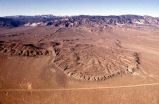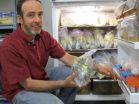(Press-News.org) BOSTON, MA—A research team led by Xian Chang Li, MD, PhD, Brigham and Women's Hospital (BWH) Transplantation Research Center, has shed light on how a population of lymphocytes, called CD4+ T cells, mature into various subsets of adult T helper cells. In particular, the team uncovered that a particular cell surface molecule, known as OX40, is a powerful inducer of new T helper cells that make copious amounts of interleukin-9 (IL-9) (and therefore called TH9 cells) in vitro; such TH9 cells are responsible for ongoing inflammation in the airways in the lungs in vivo.
The study will be published online in Nature Immunology on July 29, 2012.
In their studies, the researchers found that mice with hyper-active OX40 activities had signs of tissue inflammation, particularly in tissues lining the airway. A high amount of cells—as much as 30 percent—in these tissues were mucin-producing cells. Mucin-producing cells produce gel-like secretions that, when combined with other secretions, can form mucus or saliva.
The results mirrored previous studies of mice who over expressed IL-9 in the lung airways. Results from additional experiments confirmed that OX40 triggers both TH9 cell and IL-9 production, thereby leading to airway inflammation.
"These findings may have broad impact on how to treat chronic inflammation, such as allergic inflammation and chronic allograft rejection after transplantation, since the inflammatory texture organized by TH9 cells tends to be different and ongoing." said Li.
In addition to this translational finding, Li and his team made strides in better understanding OX40's role in the molecular mechanisms of the pathway responsible for TH9 cell induction.
According to Li, the revelation that OX40 promotes TH9 cells through TRAF6 (a protein that mediates cell signaling) and the activation of a non-canonical NF-kB pathway will point to new opportunities in drug discovery and development in treatment of TH9-related diseases.
###This research was supported by the United States National Institutes of Health and the Juvenile Diabetes Research Foundation International.
Brigham and Women's Hospital (BWH) is a 793-bed nonprofit teaching affiliate of Harvard Medical School and a founding member of Partners HealthCare. BWH has more than 3.5 million annual patient visits, is the largest birthing center in New England and employs nearly 15,000 people. The Brigham's medical preeminence dates back to 1832, and today that rich history in clinical care is coupled with its national leadership in patient care, quality improvement and patient safety initiatives, and its dedication to research, innovation, community engagement and educating and training the next generation of health care professionals. Through investigation and discovery conducted at its Biomedical Research Institute (BRI), BWH is an international leader in basic, clinical and translational research on human diseases, involving nearly 1,000 physician-investigators and renowned biomedical scientists and faculty supported by nearly $625 million in funding. BWH continually pushes the boundaries of medicine, including building on its legacy in organ transplantation by performing the first face transplants in the U.S. in 2011. BWH is also home to major landmark epidemiologic population studies, including the Nurses' and Physicians' Health Studies, OurGenes and the Women's Health Initiative. For more information and resources, please visit BWH's online newsroom.
Cell receptor has proclivity for T helper 9 cells, airway inflammation
Findings may affect how doctors treat allergic inflammation and organ transplant rejection
2012-07-30
ELSE PRESS RELEASES FROM THIS DATE:
Massachusetts Eye and Ear researchers discover elusive gene that causes a form of blindness from birth
2012-07-30
BOSTON (July 29, 2012) – Researchers from the Massachusetts Eye and Ear Infirmary, The Children's Hospital of Philadelphia, Loyola University Chicago Health Sciences Division and their collaborators have isolated an elusive human gene that causes a common form of Leber congenital amaurosis (LCA), a relatively rare but devastating form of early-onset blindness. The new LCA gene is called NMNAT1. Finding the specific gene mutated in patients with LCA is the first step towards developing sight-saving gene therapy.
LCA is an inherited retinal degenerative disease characterized ...
New discovery of how carbon is stored in the Southern Ocean
2012-07-30
A team of British and Australian scientists has discovered an important method of how carbon is drawn down from the surface of the Southern Ocean to the deep waters beneath. The Southern Ocean is an important carbon sink in the world – around 40% of the annual global CO2 emissions absorbed by the world's oceans enter through this region.
Reporting this week in the journal Nature Geoscience, scientists from British Antarctic Survey (BAS) and Australia's national research agency, the Commonwealth Scientific and Industrial Research Organisation (CSIRO), reveal that rather ...
Gene discovery set to help with mysterious paralysis of childhood
2012-07-30
DURHAM, N.C. – Alternating hemiplegia of childhood (AHC) is a very rare disorder that causes paralysis that freezes one side of the body and then the other in devastating bouts that arise at unpredictable intervals. Seizures, learning disabilities and difficulty walking are common among patients with this diagnosis.
Researchers at Duke University Medical Center have now discovered that mutations in one gene cause the disease in the majority of patients with a diagnosis of AHC, and because of the root problem they discovered, a treatment may become possible.
The study ...
Giant ice avalanches on Iapetus provide clue to extreme slippage elsewhere in the solar system
2012-07-30
"We see landslides everywhere in the solar system," says Kelsi Singer, graduate student in earth and planetary sciences in Arts & Sciences at Washington University in St. Louis, "but Saturn's icy moon Iapetus has more giant landslides than any body other than Mars."
The reason, says William McKinnon, PhD, professor of earth and planetary sciences, is Iapetus' spectacular topography. "Not only is the moon out-of-round, but the giant impact basins are very deep, and there's this great mountain ridge that's 20 kilometers (12 miles) high, far higher than Mount Everest.
"So ...
Magnetic field, mantle convection and tectonics
2012-07-30
On a time scale of tens to hundreds of millions of years, the geomagnetic field may be influenced by currents in the mantle. The frequent polarity reversals of Earth's magnetic field can also be connected with processes in the mantle. These are the research results presented by a group of geoscientists in the new advance edition of "Nature Geoscience" on Sunday, July 29th. The results show how the rapid processes in the outer core, which flows at rates of up to about one millimeter per second, are coupled with the processes in the mantle, which occur more in the velocity ...
BGI reports the latest finding on NMNAT1 mutations linked to Leber congenital amaurosis
2012-07-30
July 29th, 2012, Shenzhen, China – A five-country international team, led by Casey Eye Institute Molecular Diagnostic laboratory, BGI and Zhejiang University School of Medicine First Affiliated Hospital identified the NMNAT1 mutations as a cause of Leber congenital amaurosis (LCA), one of the most common causes of inherited blindness in children. The latest study was published online in Nature Genetics, reporting the genetic characteristics underlying some LCA patients, and providing important evidences that support NMNAT1 as a promising target for the gene therapy of LCA.
LCA ...
Chronic 2000-04 drought, worst in 800 years, may be the 'new normal'
2012-07-30
CORVALLIS, Ore. – The chronic drought that hit western North America from 2000 to 2004 left dying forests and depleted river basins in its wake and was the strongest in 800 years, scientists have concluded, but they say those conditions will become the "new normal" for most of the coming century.
Such climatic extremes have increased as a result of global warming, a group of 10 researchers reported today in Nature Geoscience. And as bad as conditions were during the 2000-04 drought, they may eventually be seen as the good old days.
Climate models and precipitation projections ...
Breakthrough by U of T-led research team leads to record efficiency for next-generation solar cells
2012-07-30
TORONTO, ON – Researchers from the University of Toronto (U of T) and King Abdullah University of Science & Technology (KAUST) have made a breakthrough in the development of colloidal quantum dot (CQD) films, leading to the most efficient CQD solar cell ever. Their work is featured in a letter published in Nature Nanotechnology.
The researchers, led by U of T Engineering Professor Ted Sargent, created a solar cell out of inexpensive materials that was certified at a world-record 7.0% efficiency.
"Previously, quantum dot solar cells have been limited by the large internal ...
Researchers analyze melting glaciers and water resources in Central Asia
2012-07-30
After the fall of the Soviet Union twenty years ago, water distribution in Central Asia became a source of conflict. In areas where summer precipitation is low, glaciers play an important role when considering the quantity of available water. The Tien Shan region is a prime example; mountain glaciers in this region contribute significantly to the fresh water supply in the arid zones of Kyrgyzstan, Kazakhstan, Uzbekistan, Turkmenistan, and Northwestern China. Like Switzerland, Kyrgyzstan serves as a water tower for its neighboring countries.
While the impact of climate ...
When the world burned less
2012-07-30
SALT LAKE CITY, July 30, 2012 – In the years after Columbus' voyage, burning of New World forests and fields diminished significantly – a phenomenon some have attributed to decimation of native populations by European diseases. But a new University of Utah-led study suggests global cooling resulted in fewer fires because both preceded Columbus in many regions worldwide.
"The drop in fire [after about A.D. 1500] has been linked previously to the population collapse. We're saying no, there is enough independent evidence that the drop in fire was caused by cooling climate," ...
LAST 30 PRESS RELEASES:
Numbers in our sights affect how we perceive space
SIMJ announces global collaborative book project in commemoration of its 75th anniversary
Air pollution exposure and birth weight
Obstructive sleep apnea risk and mental health conditions among older adults
How talking slows eye movements behind the wheel
The Ceramic Society of Japan’s Oxoate Ceramics Research Association launches new international book project
Heart-brain connection: international study reveals the role of the vagus nerve in keeping the heart young
Researchers identify Rb1 as a predictive biomarker for a new therapeutic strategy in some breast cancers
Survey reveals ethical gaps slowing AI adoption in pediatric surgery
Stimulant ADHD medications work differently than thought
AI overestimates how smart people are, according to HSE economists
HSE researchers create genome-wide map of quadruplexes
Scientists boost cell "powerhouses" to burn more calories
Automatic label checking: The missing step in making reliable medical AI
Low daily alcohol intake linked to 50% heightened mouth cancer risk in India
American Meteorological Society announces Rick Spinrad as 2026 President-Elect
Biomass-based carbon capture spotlighted in newly released global climate webinar recording
Illuminating invisible nano pollutants: advanced bioimaging tracks the full journey of emerging nanoscale contaminants in living systems
How does age affect recovery from spinal cord injury?
Novel AI tool offers prognosis for patients with head and neck cancer
Fathers’ microplastic exposure tied to their children’s metabolic problems
Research validates laboratory model for studying high-grade serous ovarian cancer
SIR 2026 delivers transformative breakthroughs in minimally invasive medicine to improve patient care
Stem Cell Reports most downloaded papers of 2025 highlight the breadth and impact of stem cell research
Oxford-led study estimates NHS spends around 3% of its primary and secondary care budget on the health impacts of heat and cold in England
A researcher’s long quest leads to a smart composite breakthrough
Urban wild bees act as “microbial sensors” of city health.
New study finds where you live affects recovery after a hip fracture
Forecasting the impact of fully automated vehicle adoption on US road traffic injuries
Alcohol-related hospitalizations from 2016 to 2022
[Press-News.org] Cell receptor has proclivity for T helper 9 cells, airway inflammationFindings may affect how doctors treat allergic inflammation and organ transplant rejection

